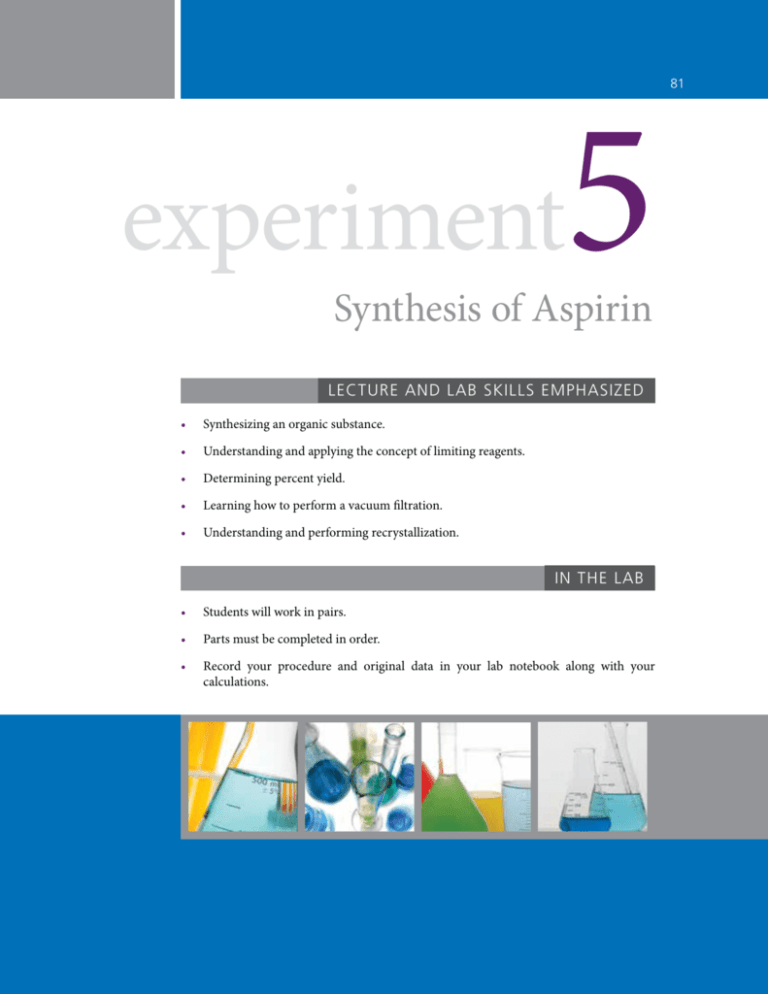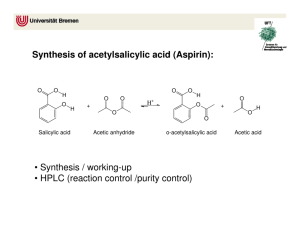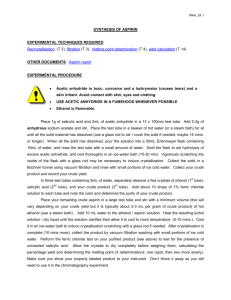Synthesis of Aspirin
advertisement

5 experiment Synthesis of Aspirin LECTURE AND LAB SKILLS EMPHASIZED • Synthesizing an organic substance. • Understanding and applying the concept of limiting reagents. • Determining percent yield. • Learning how to perform a vacuum filtration. • Understanding and performing recrystallization. IN THE LAB • Students will work in pairs. • Parts must be completed in order. • Record your procedure and original data in your lab notebook along with your calculations. 81 EXPERIMENT 5: Synthesis of Aspirin 82 • Report data collected and subsequent calculations to www.chem21labs.com. • All equipment should be returned to the correct location after use. WASTE • Salicylic acid should be disposed of in the solid waste container. • Acetic anhydride should be disposed of in the organic waste container. • Filtrates (liquids) can be washed down the drain with excess water. • Solid product and filter paper can be disposed of in the solid waste container. • Purity test solution should be disposed of in the aqueous waste container. SAFETY • Gloves and safety goggles are mandatory when anyone is performing an experiment in the lab. • Work in the hood when indicated in the procedure. • Wear long pants, closed-toed shoes, and shirts with sleeves. Clothing is expected to reduce the exposure of bare skin to potential chemical splashes. • Always wash your hands before leaving the laboratory. Additional information can be found at http://genchemlab.wordpress.com/5-aspirin. A local pharmaceutical company is looking at forming a partnership with your research company. As part of their research on your company, they have asked your supervisor to look at researcher performance and have asked that you synthesize a simple substance and demonstrate its purity. Synthesis of Aspirin Aspirin is the single most manufactured drug in the world. Aspirin’s chemical name is acetylsalicylic acid, and it is synthesized from the reaction of acetic anhydride with salicylic acid in the presence of phosphoric acid as a catalyst. The by-product is acetic acid (Figure 5.1). → H3PO4 acetic anhydride salicylic acid aspirin acetic acid F.W. = 102.04 g/molF.W. = 138.12 g/molF.W. = 180.15 g/molF.W. = 60.05 g/mol density = 1.082 g/mL M.P. = 135 °C (CH3CO)2OHOC6H4COOHCH3CO2C6H4CO2HCH3COOH Figure 5.1. Synthesis of aspirin. EXPERIMENT 5: Synthesis of Aspirin Salicylic acid has the same analgesic properties as aspirin and was used for many years as a headache medicine. However, salicylic acid is more acidic than aspirin, and is especially irritating to the mouth and stomach. Some people find even aspirin too acidic and prefer to use aspirin substitutes like acetaminophen and ibuprofen. Aspirin is produced from a reaction between acetic anhydride and salicylic acid. The structures of the reactants and products are shown in Figure 5.1. Examine them. What is changing about the salicylic acid? Being able to identify what is reacting helps organic chemists determine how a reaction occurs. Limiting Reagents In order to determine your efficiency (expressed as percent yield in chemistry), you will need to understand what is controlling your chemical reaction in terms of how much material you will produce. When you perform a chemical synthesis in lab, you measure out quantities of all reagents. These reagents react with each other, using up material as they react in order to produce products. The reagent that is used up first and controls the amount of product formed is known as the limiting reagent. The limiting reagent is the one that is completely consumed in the reaction. The limiting reagent is determined by the relative amounts of starting materials, and must be calculated for every reaction. For every reagent, you must calculate the mole quantities present, and then using the stoichiometry of the equation, how many moles of product will form. The reagent that gives the least amount of product is the limiting reagent. Theoretical and Percent Yields When calculating the yield of product, the calculation must always be based on the limiting reagent, not the reagents that are in excess. The theoretical yield is the maximum amount of product that you can recover from your experimental conditions. In order to obtain the theoretical yield, convert the amount of moles of product (from the limiting reagent) to grams, using the product’s formula weight. 83 In the laboratory, however, you will find that you will invariably lose small quantities of your material along the way. For these reasons, the actual yield of a compound (the quantity you obtain from your experiment) may be less than what you calculated. The efficiency of a chemical reaction and the techniques used to obtain the compound can be calculated from the ratio of the actual yield to the theoretical yield, to give the percent yield: % yield = = actual yield # 100 theoretical yield amount of product recovered # 100 theoretical amount of product In this experiment you will calculate the limiting reagent and the percent yield for the reaction in the synthesis of aspirin. Recrystallization Before you can determine how much material you produced, you need to make sure you are working with a pure sample. How does your sample become impure? Generally, chemists are looking at separating out any unreacted starting materials. Other impurities, like contamination caused by unclean glassware, should have been fixed by using better laboratory technique (like always cleaning your glassware before you start a reaction). Recrystallization is the most common method of purification of solids. Recrystallization is a separation process. The object is to obtain one component of a solid mixture free from contamination by any other components originally present in the mixture. Recrystallization involves three basic steps: 1. Dissolution of the solid to be purified in some hot solvent, 2. Formation of crystals as the solution cools, 3. Recovery of the purified crystals, usually by filtration. The impurities are left in solution. Purification by recrystallization does not involve formation of crystals from the hot solution by evaporation of the solvent. Such a process would simply precipitate the impurities. The success of EXPERIMENT 5: Synthesis of Aspirin 84 recrystallization depends on the characteristics of the solvent toward both the desired component and the impurities. The solvent should dissolve little or none of the desired component in the mixture at low temperatures, while it should completely dissolve the component at high temperatures. Recrystallization also does not involve any chemical reaction that changes the chemical structure of your substance. If the limiting reagent for your reaction was acetic anhydride, there is a good chance that you will have an excess of salicylic acid left at the end of the reaction, contaminating your aspirin product. We will purify our product by recrystallization of the aspirin from hot ethanol, leaving any impurities in the ethanol and recovering the aspirin by filtration. Testing the Purity of Aspirin While you may have added all of the ingredients (reagents) that when reacted together form aspirin, there is no guarantee that you successfully made what you intended. Chemists use a variety of tests to determine whether they made the intended product or not. Often, reactions do not completely react, so some starting material may remain. In this lab, we will be using a chemical test to determine the purity of the aspirin you synthesized. This particular chemical test takes advantage of one of the differences between salicylic acid and aspirin, namely the functional group called phenol. A functional group is a group of atoms that have characteristic reactivity. The phenol functional group is defined as being an –OH group attached to a benzene ring. Benzene, another functional group, consists of a 6-atom carbon ring, connected by alternated single and double bonds. Phenol OH C HC CH HC CH C H Figure 5.2. A phenol is a type of functional group that is present in a variety of organic compounds. Compounds that have the same functional group often have similar properties and react in similar ways. A phenol is present in salicylic acid but absent in aspirin. The relative purity of the synthesized aspirin can be determined by reaction of the product with Fe+3. Iron(III) reacts with phenols to form a violetcolored complex: 6C6H5OH Fe3+ → [Fe(OC6H5)6]3– 6H+ phenol violet complex If your product is pure, no violet color will be observed, since the aspirin cannot form the violet complex (not a phenol). However, if salicylic acid is present you will see a violet color develop; the amount of violet is directly related to the amount of salicylic acid present in your aspirin. Materials and Procedures 100 mL beaker filter paper 400 mL beaker spatula 10 mL graduated cylinder salicylic acid stirring rod acetic anhydride wash bottle H3PO4 (concentrated) watch glass ethanol Büchner funnel 0.1 M Fe(NO3)3 filter flask ice iron clamp semi-micro test tube ring stand Synthesis of Aspirin 1. Obtain approximately 2 g of salicylic acid and determine its mass accurately; record the exact value in your data table. Transfer to a 100 mL beaker. 2. Do this step in the hood. Measure ~3 mL of acetic anhydride with your small graduated cylinder, record the exact volume and add this to the 100 mL beaker with salicylic acid. Add 5 drops of concentrated phosphoric acid. EXPERIMENT 5: Synthesis of Aspirin 3. Do this step in the hood. Place the 100 mL beaker in the 400 mL beaker of warm water (70–80°C). Use a stirring rod to get the reactants into solution. Allow the mixture to react for about 5 minutes in the warm water. 4. Remove the 100 mL beaker, and while the mixture is still warm, carefully add about 1 mL of cold water, drop by drop to the 100 mL beaker. You will now hydrolyze any excess acetic anhydride. Use caution: The hydrolysis may cause spattering. Filter paper Büchner funnel To aspirator on water faucet Filtration flask M enayd ©H Filtrate C L il, L cNe 5. Add 15 mL of water and cool the 100 mL beaker in a larger beaker with ice water. Stir with a stirring rod. Allow 5 minutes for the aspirin to crystallize from the solution. In the meantime, put a wash bottle filled with distilled water in ice water to cool. You will need cold water in the filtration step to follow. 85 Separation Technique: Suction Filtration Figure 5.4. Separation technique: Suction filtration. 7. Collect the crystals by pouring the solution onto the filter paper. Make sure that the water is fully open for maximum suction filtration. Do not disturb the crystals on the filter paper or you will break the filtration vacuum. Wash any product in the beaker into the funnel with cold distilled water; rinse your stirring rod as well. Remember, any product you lose here will affect your percent yield. ©Hayden-McNeil, LLC Figure 5.3. Hot water bath. 6. Set up a Büchner filtration system as shown in Figure 5.4. Place a filter paper in the funnel, and wet the paper thoroughly with distilled water. Turn the water on to allow the paper to be sucked onto the funnel. In order to ensure a good seal, you may want to add a small amount of water into the funnel. 8. Allow the filtration to continue until you see no more water droplets fall from the funnel. Turn the water off. Insert a spatula between the edge of the paper and the side of the funnel and lift the paper from the funnel. Transfer the product to a 100 mL beaker. Scrape all the product from the filter paper with a spatula. Work carefully as you don’t want to lose any product in this step. Note the color and texture of your crystals in your data table. Recrystallization of Aspirin 9. Add about 3 mL of ethanol to the crystals. Warm the solution in a hot water bath. If all the crystals do not dissolve, add another 1–2 mL of ethanol. You want to use as little ethanol as possible in the recrystallization step. EXPERIMENT 5: Synthesis of Aspirin 86 10. Pour 15 mL of warm water into the alcohol solution. Cover the beaker with a watch glass and set aside to cool. (The crystallization process can be sped up by putting the beaker in an ice bath.) Allow 5 minutes for the crystals to crystallize from the solution. 11. Record the mass of your clean, dry filter paper and filter the crystals using suction filtration as before. While the filtration is in progress, determine the mass of a dry, clean watch glass. 12. When the filtration is complete, remove the filter paper and place the paper and crystals on the watch glass. Label your watch glass before putting it in the oven and dry your aspirin in the oven at 110°C for 10–15 minutes. 13. When your product is dry, remove your sample from the oven and allow it to cool. Weigh the watch glass with the aspirin product and record the value in your data table. Record the color and texture of the recrystallized aspirin. Testing the Purity of Aspirin 14. Dissolve a small spatula point of your aspirin in about 50 mL of warm water. Transfer 1 mL of this solution to a test tube. Add 3 drops of the iron reagent (Fe(NO3)3). Shake well for 2 minutes. Record all observations. Data Analysis Make sure to show all of your calculations in your lab notebook as a record of how you completed your calculations. Don’t forget to include your units and correct number of significant figures! Then, go onto Chem21 and report your results. 1. What was the mass of aspirin synthesized? 2. What is the maximum mass of aspirin possible if salicylic acid is the limiting reagent? 3. What is the maximum mass of aspirin possible if acetic anhydride is the limiting reagent? 4. What is the theoretical yield of aspirin? 5. What is the percent yield of aspirin? 6. What happened when the iron nitrate solution was added to the aspirin? Make sure to respond with both an observation and the interpretation of your result.






